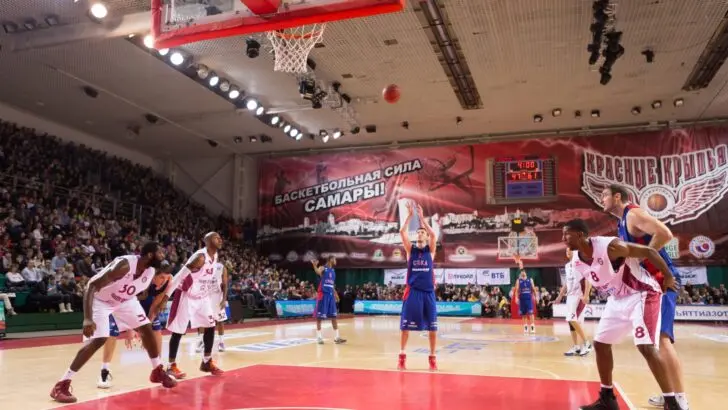The free throw is often considered one of the easier shots in the game. An unobstructed shot that is 15 feet from the line, the free throw shot can help a basketball team to secure the win and ensure a significant margin of victory.
However, oftentimes, while watching an NBA game or playing a basketball game, fans will notice that most players will remain securely on the ground while taking the shot. Below, we are going to review just whether or not a basketball player can jump during a free throw shot and just why most players opt not to.
In addition, we will review the current basketball rules and regulations to see if jumping while taking a free throw shot is permissible. Lastly, we will speak to how remaining planted on the ground can help the shot to be more effective and more likely to be a successful one.
What Is A Free Throw?
In basketball, a free throw or foul shot, is an unopposed, unobstructed attempt to score the basketball from behind the free-throw line. The free-throw line is generally placed approximately 15 feet from the center of the basketball hoop on both sides of the court.
However, the free throw shot is usually awarded to a player after a foul or penalty has occurred. Similar to a penalty shot in other sports, a free throw shot will be awarded to a player, who in the act of shooting, has been fouled by an opposing player.
In addition to being awarded after a penalty has been assessed, free throw shots will also be awarded in the case of a technical or flagrant foul.
Similarly, free throws will be awarded if a team is over the foul limit, or when a team has committed the maximum number of fouls in a quarter before they are in the penalty and the opposing team begins to be granted free throws for each foul thereafter, no matter if it’s a shooting foul or not.
How Many Free Throws Does a Player Attempt?
Depending on the situation and occurrence of the foul, a player can be awarded one, two, or three free throw attempts. The number of foul attempts differs depending on the type of foul and whether completion of the field goal resulted in a made attempt.
Typically, one free throw attempt is provided for any player who successfully attempts and completes a two or three-point field goal. In addition, one free throw attempt can be awarded to a player after the opposing team has been assessed with a technical foul.
In addition, two free throw attempts will be awarded to any player who attempts a two-point field goal yet fails to successfully make the shot attempt. Similarly, two free throw attempts will be awarded to an individual player after the opposing team has been assessed with a flagrant foul.
Lastly, three free throw attempts are reserved for any player who attempts, but fails to make, a three-point shot while being fouled. In this case, the player attempting the shot will be awarded with three free throw shots.
Are Free Throws Difficult?
Generally, free throws tend to be one of the easiest shots in basketball. As the free-throw line is just 15 feet from the line and the shot attempt is taken unobstructed, most players are able to make the majority of their free throw shots without any problems.
However, larger players and players who play the center position tend to shoot free throw shots more poorly then their guard and forward counterparts.
For NBA centers in the 2020-21 season, the average free throw percentage stood at 71.4%. In comparison, power forwards in the NBA had a 76% free throw percentage, small forwards had a 78.9% free throw shooting percentage, shooting guards had an 81.1% free throw percentage, and point guards had a 80.5% free throw percentage.
However, practicing and focusing on your free throw shots can definitely help you to become a more adept free throw shooter. As the free throw shot is one of the most common shots in the game, it is especially important to focus and practice on the shot so that you may be prepared come game time.
Can Basketball Players Jump During a Free Throw Shot?
According to the official NBA rules, a player is allowed to jump during a free throw attempt. In fact, per the official NBA rules, there is no specification as to whether or not a player is allowed to jump or not during the act of taking a free throw shot.
Rather, and again per the official NBA rules, a free throw shooter may not step over the plane of the free throw line until the ball touches the basket ring, backboard or the free throw ends.
With this in mind, if a player opts to shoot the free throw shot while jumping, they must be mindful to not cross the free throw plane until the basketball has made contact with the basket ring or backboard or until the free throw ends.
Why Don’t Basketball Players Jump During a Free Throw?
While basketball players are permitted to jump while attempting a free throw shot, most opt not to. The reasons for this are varied but generally center around consistency. As the free throw shot requires concentration and focus, by not jumping, most players are able to focus solely on the shot and the act of shooting.
By jumping while attempting a free throw shot, basketball players will have less focus and accuracy towards the rim.
Rather, most basketball players will opt to shoot the free throw shot will remaining planted on the ground as to provide themselves with as much focus and concentration as possible.
Similarly, with the official NBA rule prohibiting crossing the free throw line plane until the basketball has touched the rim or backboard, most basketball players are wary to jump during the shot in an attempt to minimize accidentally doing so.
